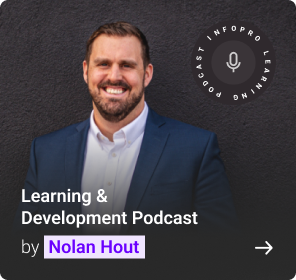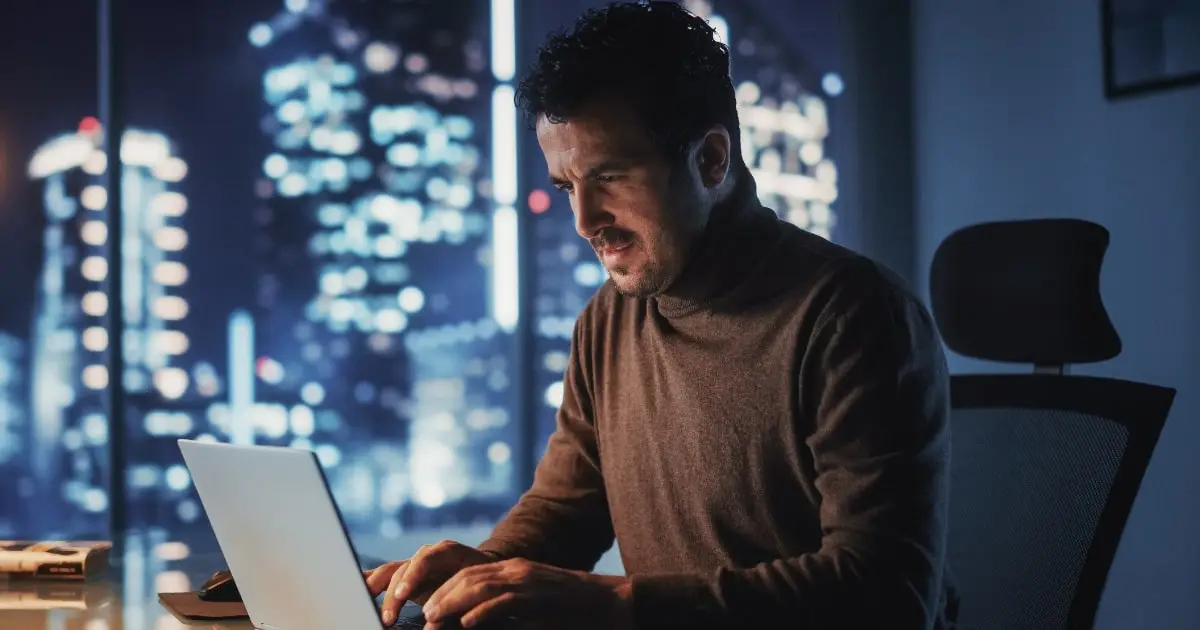With Augmented Reality (AR), you can superimpose digital information onto your real surroundings, making learning more interactive and fun. Conversely, Virtual Reality (VR) whisks you to incredible virtual worlds where you can explore, experiment, and learn in ways you never thought were possible. These technologies are like the superheroes of education, breaking free from the constraints of traditional classrooms and catering to different learning styles. They make complex concepts easier to grasp and bring a sense of adventure to your learning journey.
In this podcast, Fraser Bowie, the founder of The Bowie Group LLC and an L&D visionary, joins Nolan Hout, Senior Vice President at Infopro Learning, to discuss the transformative impact of AR and VR technologies in corporate training. He highlights the revolutionary potential of VR in learning, comparing it to the Gutenberg press and the Internet’s impact. The conversation explores diverse AR/VR applications, from sales training to empathy-building experiences and aiding the visually impaired. Fraser emphasizes how these technologies allow users to step into different perspectives, making them as powerful as books or the Internet. His insights shed light on the opportunities and challenges presented by these cutting-edge technologies in L&D.
Listen to the podcast to learn more:
Question:
Where did you start, and what got you on this exciting path you’re on today?
Question:
What are you up to today? If you wouldn’t mind going into that.
Question:
What makes AR/VR so important in the learning & development community?
Question:
What have you found to be like somebody who does no AR/VR today?
Expert profile:

Fraser Bowie
Fraser Bowie, the founder of The Bowie Group LLC, is a visionary leader with over two decades of experience at the forefront of technology and innovation. His career highlights include pioneering the first live-stream broadcast of a multi-day music festival and deploying cutting-edge technologies like VR/AR for interactive training. Fraser is known for his hands-on approach, guiding teams from research to deployment. He encourages personal and professional growth, challenging teams to think creatively. His exceptional interpersonal skills and commitment to pushing boundaries make him a driving force in technology and business innovation.

Nolan Hout
Nolan Hout is the Senior Vice President at Infopro Learning. He has over a decade of experience in the L&D industry, helping global organizations unlock the potential of their workforce. Nolan is results-driven, investing most of his time in finding ways to identify and improve the performance of learning programs through the lens of return on investment. He is passionate about networking with people in the learning and training community. He is also an avid outdoorsman and fly fisherman, spending most of his free time on rivers across the Pacific Northwest.
An excerpt of the discussion follows:
Nolan:
Hello, everyone, and welcome to season two of the Learning and Development podcast sponsored by Infopro Learning.
As always, I am your host, Nolan Hout. I’m very excited to get into the show today that will be centered all around AR and VR, but if you’d allow me, I want to take a second and thank everyone who turned into our first season and all my guests.
I started this podcast over a year ago, thinking it’d be lucky to get four or five people to talk to me, and what ended up happening is that I had a backlog of guests that stretched my capacity to its absolute limits. I’m so appreciative of my guests’ contributions, even though it required some additional time to bring these episodes to life.
Never in a million years did I think this thing would take off to the point where I’d have people coming up to me at conferences and referencing this podcast. And I apologize to those people for discovering that I have a face for podcasting. I’m getting a little long-winded here, so thank you again from the bottom of my heart. Let’s get to our first guest of the second season.
This is a guy I have known for quite some time. Around eight years ago or so, we met at a Brandon Hall award ceremony and spent quite a few hours celebrating our respective wins.
This gentleman is Fraser Bowie, a visionary in the L&D space who has been in for decades.
Whether it’s helping Verizon introduce augmented and virtual reality into their learning ecosystem or acting as an AR/VR consultant to several other Fortune 500 companies with their product development at NuEyes Technologies.
Today, we’ll talk with Fraser about some AR and VR technologies, how we apply them in corporate training, and some use cases outside the training world.
Everyone, please join me in welcoming my first guest of Season 2, Fraser Bowie.
Hello, Fraser. Welcome to the podcast.
Fraser:
Thanks for having me. I’m glad to be here.
Nolan:
We have a packed agenda with a topic many people are incredibly interested in. But first, I’d like people to understand better your journey to where you are today.
Obviously, with where you are leading this product in the AR/VR space. Of course, you didn’t start your career that way because AR/VR didn’t even exist right at that point since it’s so new.
So, if you wouldn’t mind, Fraser, give us a little bit of an understanding of:
Where did you start, and what got you on this exciting path you’re on today?
Fraser:
Sure. I have an odd and diverse background. I have a degree in graphic design, but I’ve always had a passion for technology. I was one of the first graduating classes with experience and learning using computers to do graphic design versus just pen and paper.
I fell in love with technology because it was all about pen and paper before that. And then, when I went to college and started realizing it could be more than that of the possibilities of it, that’s how I got hired on.
My first job as a retailer was doing traditional advertising with pay stubs and stack cameras and things like that. But they were transitioning to the computer. So, the fact that I knew both worlds were advantageous.
I just had this from that point onwards, had this in grade school, and had done my programming on the Apple Two and different things. But I started to get this passion for how technology can improve challenges in business, life, or whatever.
I was always pushing those boundaries, whether that was broadcasting the first live music festival on the Internet back in the 90s or whether it was jumping into AR and VR 8-9 years ago. I’ve always looked at how we can improve what we’re doing today with technology and what challenges we are having that might bring this.
And so, through my very different jobs and different careers, technology has always led. It was always one of the first e-commerce sites to be out there, one of the first real national retailers to start pushing e-commerce websites and even delivering from the store, which I fell into when I was at Verizon for about 11 years.
I fell into AR and VR because I was with their L&D department, and how could we take training to the next level? How can we give people more retention? How can they get a more immersive experience, all those sorts of things? I started doing that, and now not only have I created a bunch of training in the space, but I’m now building hardware in space and software. It’s been a crazy journey, but it’s been a lot of fun, especially once I got into AR and VR because the potential was phenomenal.
Nolan:
If you don’t mind, Fraser, since most of our listenership here is in that L&D field. What brought you into L&D at Verizon, that particular area?
As you said, you had done so many different things, all on the cutting edge of technology and business.
What brought you into that particular line of Verizon? It is very well known for having cutting-edge learning, but how were you brought into that?
Fraser:
I came in through a user experience role. I was there to help improve some of our knowledge and other systems from just interaction and human experience. A human interaction and UI experience sort of role.
And that just grew because I think my obsession with technology and solving business problems is how humans interact. So that’s how I came into it, and then it was also at the right time.
I fell in love with L&D because, at the time, my kids were starting to go to school, so I was watching them learn from others than just discovery.
Do you know, up until that point, much of it is discovery? As they walk for the first time, they hear the radio for the first time. It’s a lot of discovery, but once they start going to school, it’s a lot of teaching. I was not a great student, so I never thought I would be in L&D, but it just came together at the right time that I got obsessed with how we can improve things. What are the challenges we are having?
So eventually, with Verizon, I ended up leading an innovation team within L&D just looking at everything from solving how we do class rosters to getting the latest information updated as quickly as possible, allowing people to create forums to give feedback immediately, all that sort of thing which came out of it.
And then I became obsessed with AR and VR, and I was thinking of how do we get the person climbing the pole to get the information they need when they’re trying to do something without having to climb down, open up their laptop and look at something? So, let’s give him an AR, and that sort of thing got me going with it.
Fraser and Nolan further discuss cost considerations and potential pitfalls in AR/VR implementation, stressing the importance of identifying use cases that save money and enhance learning outcomes.
Some interesting questions asked during the podcast are:
- What you’re up to today? If you wouldn’t mind going into that.
- What makes AR/VR so important in the learning & development community?
- What have you found to be like somebody who does no AR/VR today?
- You mentioned assisted reality, augmented reality, virtual reality. Can you give the quick 140 characters of each?
- Somebody eventually decided it was worth the extra cost to do it in AR and VR. How do you help companies make that choice?
- What are the things we should be avoiding? What are the pitfalls? What are the mistakes that everybody or most people make when starting to get into this that you might help others avoid?






